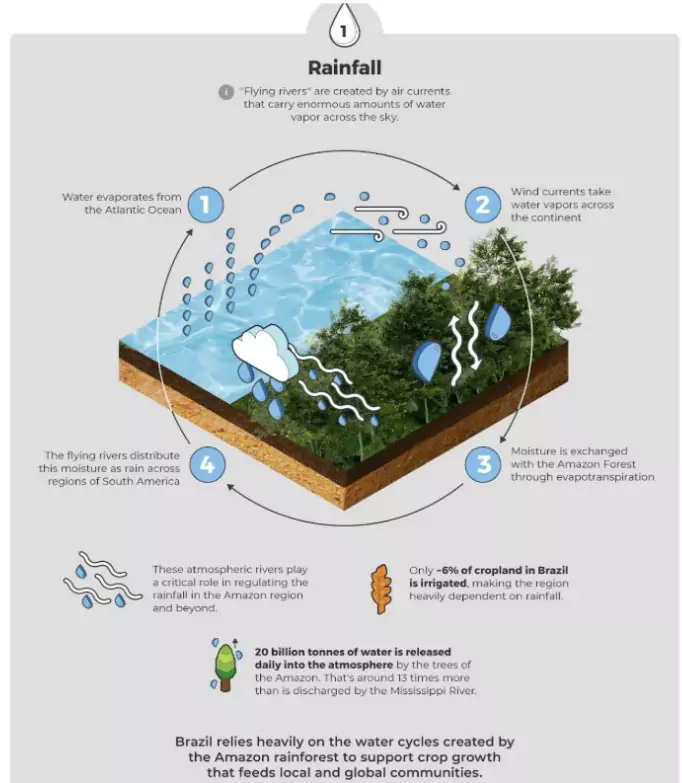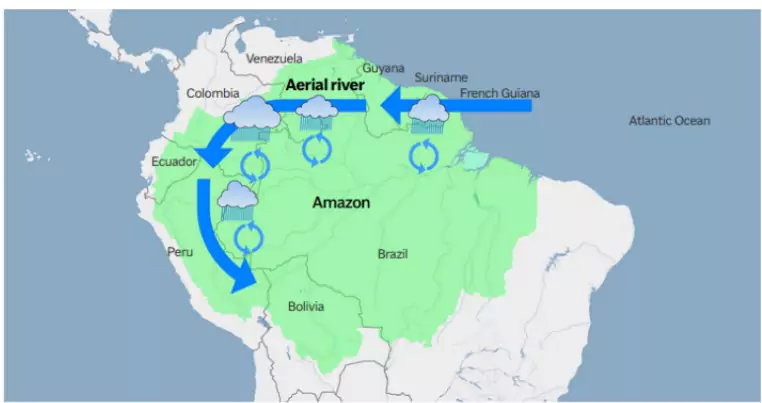New research by the Monitoring of the Andean Amazon Project (MAAP), part of Amazon Conservation, warns that continued deforestation is disrupting the Amazon’s “flying rivers”.
- The study highlights how forest loss is not only an ecological crisis but also a hydrological one, altering the continent’s climate balance.
About “Flying Rivers”

- Definition: “Flying rivers” are airborne moisture streams formed when trees in the Amazon rainforest release water vapour through evapotranspiration.
- This vapour joins atmospheric currents, creating aerial rivers of humidity that travel westward across South America, bringing rainfall to the Andes, central Brazil, and even Argentina.
- Role in Climate Regulation:
-
- Trees recycle about half of the Amazon’s rainfall through evapotranspiration.
- These atmospheric moisture flows maintain regional rainfall patterns, agriculture, and river systems.
- Origin of the Term: Coined by Brazilian climate scientist Carlos Nobre in 2006, to describe the invisible rivers of vapor sustaining the Amazon ecosystem.
- Thus, the Amazon functions as a vast biotic pump — releasing and redistributing moisture that sustains much of South America’s rainfall.
Findings of the MAAP Analysis

- Tree Loss Impact: Continuous deforestation has broken the forest’s hydrological “pump”, reducing westward moisture flow.
- Visible Impacts:
- Peru: Crop failures and droughts have withered harvests.
- Ecuador: Hydroelectric dams are struggling as river levels fall.
- Brazil: Extensive forest fires and prolonged dry spells.
- Scientific Concern:
- Tree loss reduces the region’s ability to “pump” moisture into the atmosphere, weakening the flying river system that sustains the rainforest itself.
- This feedback loop risks pushing the Amazon towards an ecological tipping point — a savannization process marked by irreversible drying and biodiversity loss.
Global Implications
- Hydrological Crisis:
- Declining rainfall threatens agriculture, hydropower, and drinking water supplies across South America.
- Weak “flying rivers” reduce water availability in Ecuador, Peru, and southern Brazil, intensifying energy and food insecurity.
- Carbon and Climate Feedback:
- Fewer trees mean less carbon sequestration, while droughts and fires release stored carbon — converting the Amazon from a carbon sink to a carbon source.
- Loss of the rainforest’s cooling effect may accelerate regional warming and disrupt global climate circulation patterns.
- Ecological and Biodiversity Risks:
- Conversion to savanna will drastically reduce biodiversity, impacting thousands of endemic species.
- The collapse of the rainforest ecosystem would undermine its role as a global oxygen producer and carbon regulator.
![]() 4 Oct 2025
4 Oct 2025



